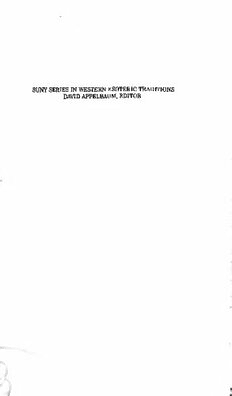
Gnosis: An Esoteric Tradition of Mystical Visions and Unions PDF
Preview Gnosis: An Esoteric Tradition of Mystical Visions and Unions
SUNY SERIES IN WESTERN ESOTERIC TRADITIONS DAVID APPELBAUM, EDITOR Gnosis An Esoteric Tradition of Mystical Visions and Unions Dan Merkur State University of New York Press Published by State University of New York Press, Albany © 1993 State University of New York All rights reserved Printed in the United States of America No part of this book may be used or reproduced in any manner whatsoever without written permission except in the case of brief quotations embodied in critical articles and reviews. For information, address State University of New York Press, State University Plaza, Albany, N.Y, 12246 Production by Diane Ganeles Marketing by Fran Keneston Library of Congress Cataloging-in-Publication Data Merkur, Daniel. Gnosis: an esoteric tradition of mystical visions and unions / Dan Merkur. p. — cm. — (SUNY series in western esoteric traditions) Includes bibliographical references and index. ISBN 0-7914-1619-4 (hard : alk. paper). — ISBN 0-7914-1620-8 (pbk. : alk. paper) 1. Visions—History. 2. Mysticism—History. 3. Gnosticism- -History. 4. Imagination—History. 5. Psychoanalysis and religion. 6. Jung, C. G. (Carl Gustav), 1875-1961. I. Title. II. Series. BF1101.M47 1993 291.4'2—dc20 92-35390 CIP 10 987654321 Incredulity is given to the world as a punishment. —Elias Ashmole, “Prolegomena” Theatrum Chemicum Britannicum (1652) Contents Preface ix Part One: Jung, Active Imagination, and the Gnostic-Alchemical Hypothesis 1. The Study of Mystical Experiences 3 2. Jung, Silberer, and Active Imagination 37 Theories of Spiritual Alchemy 55 (4) The Alchemical Production of Gold 77 Part Two: A History of Gnosis 5. Defining Gnosis 111 6.. The Gnostic Journey to the Ogdoad 117 The Recital of the Chariot 155 1/ 8. Muhammad and his Mi'raj 181 9. Islamic Gnosis and the World of Imagination 199 10. The Passage of Gnosis to the Latin West 237 Notes 269 Works Cited 339 Index 379 vii Preface In 1913 Carl Gustav Jung developed a procedure for inducing visions that he termed “active imagination.” He combined hypna gogic states with visualization techniques in order to induce waking imaginations that were autonomous, as are dreams, and not con sciously directed, as are daydreams. Jung’s procedure has since had a variety of successors. Related practices have also been developed in Western occultism and New Age spirituality. The significance of active imagination for the history of religion remains to be assessed. Several intriguing speculations have been offered. Jung alleged the use of active imagination in gnosticism, al chemy, The Spiritual Exercises of St. Ignatius Loyola, and Friedrich Nietzsche’s Thus Spake Zarathustra. Henry Corbin made a case for active imagination in the Islamic gnosis of medieval Isma'ilism, Avi cenna’s Neo-Aristotelian mysticism, and theosophical Sufism. An toine Faivre has suggested that a blend of gnosis and active imagination has been part of Western esotericism since its system atization in the Italian Renaissance. The present study is, to my knowledge, the first systematipjiis- tory of active imagination in Western culture. As I am not a Jun- gianri have reconceptualized the topic in terms of both method and perspective. My historical findings remain exploratory. I hope to have identified the major trends of the history, but at this stage in the research all results must be considered provisional. I have cited the data that I have happened to find; there must be oversights, small and large. It is my thesis that a paired use of visionary and unitive expe riences, dependent for the most part on active imagination, consti tuted the gnosis, “knowledge,” at the mystical core of the gnostic trajectory in Western esotericism from late antiquity to modern times. No one has previously written a history of visionary practice in the West. Much less has anyone suggested that Western mystics, ix x Preface some of whom are known to have experienced both visions and unions, ever made a tradition of the dual practice. Evidence that scholars have often treated as marginal or peripheral to the general history of Western mysticism or, at best, have discussed as minor curiosities or oddities have here been presented as a discrete tra jectory. My demonstration that there has been such a tradition is, in many ways, as significant as its identification as gnostic. The gnostic uses of active imagination were transmitted, I ar gue, by much the same routes as Greek philosophy and science: through early Islam, where they were considerably developed before passing through medieval Judaism, which made important contri butions before passing the tradition onward to the Latin West, /.where gnosis entered alchemy for the first time. For reason, in Melville’s phrase, of “Time, Strength, Cash, and Patience,” I have deferred discussion of one of the most interesting episodes in the history of gnosis: the origin and early development of the kabbalah. The omission will be repaired as circumstances permit. Most of this book was written from 1990 to 1992 when I was a Research Reader at the Centre for Religious Studies, of the Univer sity of Toronto, Canada. At different points over the years, this project has profited from the help of Antoine Faivre, Ithamar Gru- enwald, David J. Halperin, Moshe Idel, Todd Lawson, June McDaniel, Jordan Paper, Richard Pero, Robert A. Segal, Charles and Dena Taylor, Steven M. Wasserstrom, Elliot R. Wolfson, and the members of the Alchemical Society of Canada. I extend my thanks to all. An earlier version of chapters 3 and 4 was published in Ambix 37 (1990), 35-45. Part One Jung, Active Imagination, and the Gnostic-Alchemical Hypothesis
